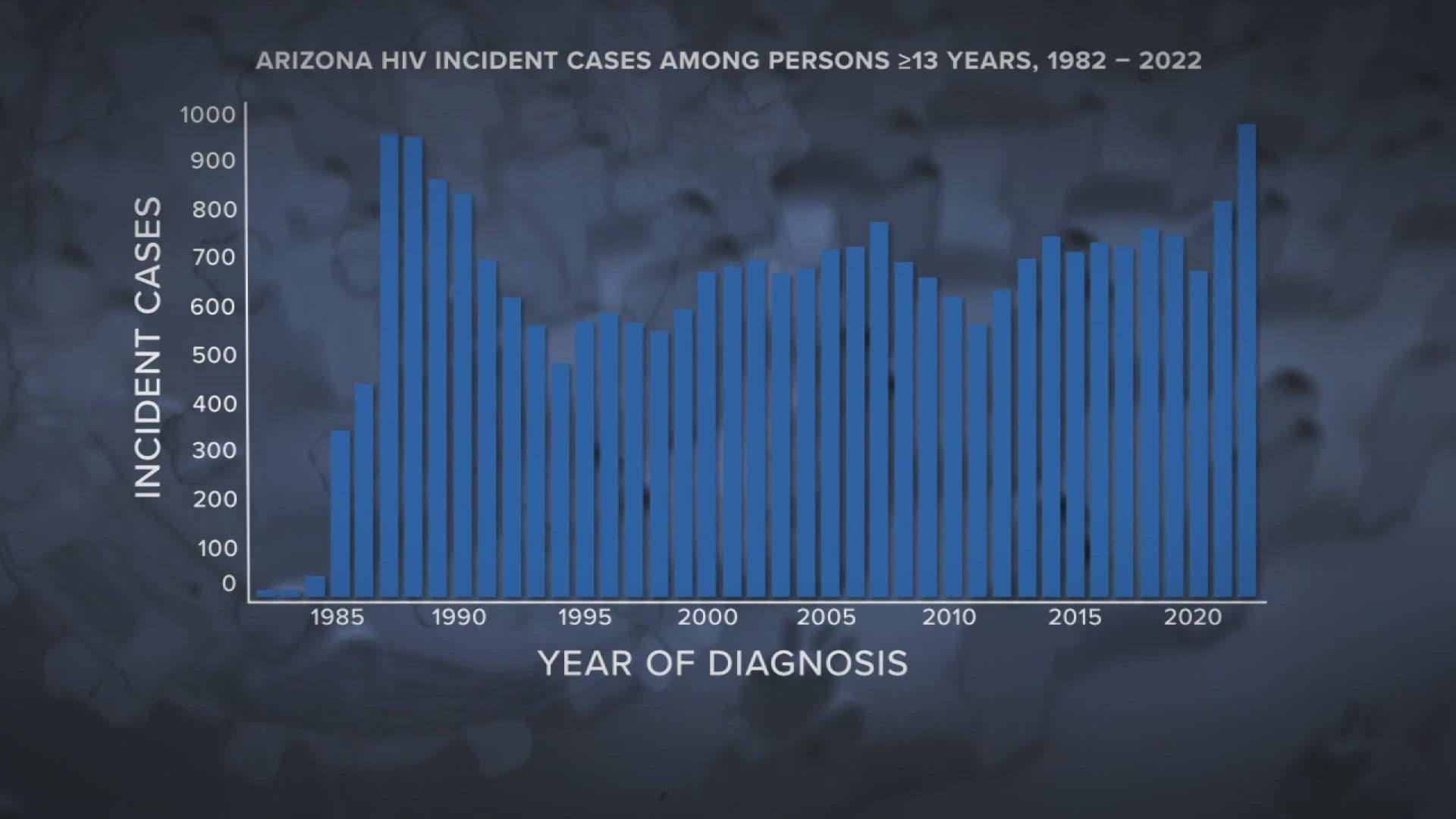PHOENIX — The rate of HIV infections in Arizona increased by 20% in 2022, according to the Arizona Department of Health Services. Nearly 1,000 Arizonans learned they had HIV throughout the year.
The increase is the highest number of new cases identified in the state since the late 1980s, the height of the HIV epidemic, according to the report.
"That was a significant increase in new HIV cases in Arizona, compared to prior years," Ricardo Fernandez, the chief of HIV and Hepatitis C at the ADHS, said. "The increase in incident cases was a little bit of a surprise. I think we expected an increase, but maybe not quite as high as what we saw. So, that was a little bit unexpected."
By the end of 2022, there were 19,894 people living with HIV and AIDS in Arizona, the 2023 AZDHS HIV surveillance report said.
'HIV is only dangerous when it's unknown that it's there'
Eric Morales learned of the increase in cases on his first day with the Southwest Center for HIV/AIDS, far from his first day working on helping those in the community. Since learning of his own HIV diagnosis in 2017, he has made it his personal mission to help others living with HIV.
"So, the fact that there's a 20% increase in HIV cases means that there's lots more work to be done," Morales said.
Morales says one major hurdle for bringing down cases is ending the stigma surrounding talking about it and getting tested.
"We are not going to end the virus until we all continue to talk about it normally, regularly and consistently, we need to make sure that were ending the stigma really," Morales said. "HIV has such a negative connotation."
After living with the disease for six years, Morales said knowledge is power.
"HIV is only dangerous when it's unknown that it's there," Morales said.
'Very important that we do expand testing'
HIV testing rates were also up 19% in 2022 after the pandemic virtually shut down testing in 2020.
"In 2020, a lot of our community based organizations, because of the risks of COVID, we asked them to stop testing," Fernandez said. "Testing that was ADHS funded in 2020 was under 40,000 HIV tests, compared to over 69,000, in 2022. So, we've seen testing increase, and then we think that part of it is, it also potentially represents just an actual increase in new HIV cases."
That increase in testing does not account for the entire increase in new cases.
"Sometimes increased testing can cause numbers to to go up a little bit artificially. I think that it's, it's still very important that we do expand testing as much as we are able to and that as as many folks as possible are doing HIV testing, so that someone's HIV diagnosis can be caught as soon as possible," Fernandez said.
RELATED: Syphilis and other STDs are on the rise. States lost millions of dollars to fight and treat them
HIV is no longer a 'death sentence,' prevention is key
"When it comes to prevention, sometimes it comes with a stigma of promiscuity or really just a misunderstanding with permit with prevention being a green light to to engage in risky activity," Morales said. "Prevention sometimes has a negative connotation, although prevention really is what is going to make a difference when it comes to lowering the new infection rates."
Over the last four decades, medical advancements have made HIV easier to prevent and easier to treat.
"Once upon a time it was a death sentence to be initially diagnosed with HIV and AIDS and now that's no longer the case," Morales said.
There is a highly effective preventative treatment called PrEP, or pre-exposure prophylaxis, that can prevent a person from getting HIV, which comes in pill and injectable forms. Fernandez said there are still too few people taking preventative treatments that are readily available.
"We would like to see more folks taking that medication so that they can't acquire HIV, and in particularly, among folks that are that are historically less well-served by the health care system, like our Black community or in our Hispanic community, that tend to use treatments like that less than their white counterparts for example," Fernandez said.
One free service that offers testing and prevention services is Chicanos por la Causa.
"It is important because this is something that we can control," Leonetti Garcia with the organization said. "There has been scientific innovation that helps and control the virus itself to where people are undetectable."
It is easy to get tested
The department of health recommends everyone get tested at least once in their lives, and people who are sexually active should get tested more often.
"We are here and we're available and our services are free, and that we can provide the help that they may be seeking here, just around the corner in their neighborhood," Salvador Morales with Chicanos por la Causa said.
To find a testing location or to request a home test kit, visit their website here. The Southwest Center also provides testing through walk-ins and appointments.
The Arizona Department of Health Services also has a website to find where to get tested, which can be found here.
"There are so many options in the community to get tested. When I was diagnosed with HIV in 2017, the way I found out was because of an at home kit. So, I was able to, in the comfort of my own home, take that test-- that's still an option today," Morales said. "You can go onto a website, you can walk into any one of the clinics, you can walk into this building here, Parsons Center for Health and Wellness, and there are several options for you to come in and get tested."
Up to Speed
Catch up on the latest news and stories on the 12News YouTube channel. Subscribe today.

